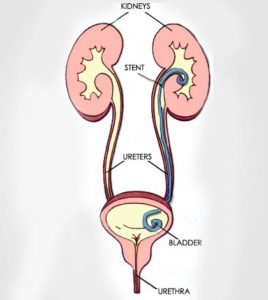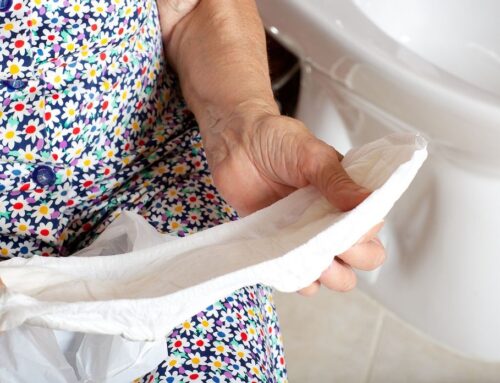What is a ureteral stent?
 Ureteral stents are small tubes inserted into the ureter to treat or prevent a blockage that prevents the flow of urine from the kidney to the bladder. The most common reason for ureteral stents is the treatment of kidney stones. Below are the answers to some of the questions we receive about ureteral stents.
Ureteral stents are small tubes inserted into the ureter to treat or prevent a blockage that prevents the flow of urine from the kidney to the bladder. The most common reason for ureteral stents is the treatment of kidney stones. Below are the answers to some of the questions we receive about ureteral stents.
What is a ureter?
A ureter is the tube-like structure that transports the urine from the kidney to the urinary bladder.
Ureters run vertically (up and down) in the mid-part of the abdomen. Typically there is one ureter for each kidney. Some people are born with two ureters to one kidney or two ureters to both kidneys. This is called duplication.
What is a stent?

A stent is a small hollow tube that is placed into the ureter. It’s flexible and approximately 10 inches in length.
When placed in the ureter, the top portion of the stent has a small curl that sits in the kidney and the opposite ends curls in the bladder.
Stents may have a string on the end that is visible outside the body. Not all stents have a visible string.
Why are ureteral stents placed?
A ureteral stent is placed to allow urine to flow from the kidney to the bladder when the normal flow is blocked. It may also be placed to prevent blockage.
What can cause a blocked ureteral tube?
Kidney stones are the most common reason for placing a ureteral stent. Other reasons include stricture (abnormal narrowing of the ureter), and outside forces such as a tumor pushing on the ureter and causing a blockage.
Inflamed, swollen, or damaged ureteral tubes in need of healing may have a stent placed to keep the kidney draining during the healing process.
What symptoms can be caused by a stent?
Normal symptoms you may experience when a stent is in place include:
- Blood in urine – Can range from light pink tinged urine, to a darker color similar to red wine.
- Dysuria (burning with urination) – this can be mild to moderate. Dysuria can usually be relieved by increasing fluid intake and avoidance of certain drinks, food, and some medications.
- Urgency – the feeling/sensation you get when you have to go
- Frequency – going to the restroom more often than normal. Frequency can range from every few minutes, to once an hour. Frequency will increase when increasing fluid intake.
- Spasms of the ureter or bladder. A cramping-like sensation in the mid to low abdomen, often described as feeling like a muscle cramp
Some symptoms are not normal with a stent in place, and you should see your doctor. These include:
- Constant dark bloody urine that does not ease up with increased fluid intake.
- Thick clots or tissue in the urine that is causing any difficulty urinating
- Urinary retention, meaning you are unable to urinate at all. Small dribbles of urine with an increasing discomfort in your lower abdomen can suggest the beginning of retention, and you should notify your doctor.
- Severe pain of any kind not relieved with any medications, either over-the-counter or prescription medication.
- Persistent fever over 101.8 °
Can I work with a ureteral stent?
Yes, you can continue your normal activities with a stent in place. Though there may be some physical discomfort, a stent will not physically limit you.
Lifting, or reaching your hands above your head repeatedly may cause bleeding, or worsening bleeding that may already be present. This is related to increased irritation of the stent on your bladder.
How long am I going to have the stent in place?
The length of time the stent will remain inside your ureter depends on the reason it was placed. They should only be removed in the timeframe recommended by your physician, not any sooner or later.
- Pre-stone treatment – usually a week or two prior to surgery
- Post- stone treatment
- After a simple ureteroscopy where the stone and any fragments were removed: 2-3 days
- After Lithotripsy (sound wave therapy to break stones up): 7-14 days.
- Due to an outside force putting pressure on the ureter by a tumor or other growth:
- Up to 3 months, and depending on if the growth will be removed, a stent can be left in place for years. However, stents must be changed on a regular basis of every 3-4 months.
- Due to a stricture, or narrow ureter:
- This will depend on the treatment planned by you and your physician and can vary.
How is the stent removed?
If the string is visible outside the body, it can be simply removed in office without the use of any procedures or specialty equipment. This is used for short term stents (needed for 1 week or less). A nurse practitioner can do this in the office within days of your surgery.
Ureteral stents that do not have a visible string, or were placed to allow a longer healing period, will require a minor in-office procedure.
A small, flexible scope called a cystoscope is placed into the urethra that allows the doctor to visualize the stent from inside the bladder. Then, the doctor grasps the stent with tiny clamps attached to the scope and removes the stent.
A physician must do this procedure, and it must be scheduled ahead of time. An X-ray may be required prior to removing the stent to ensure no large stone fragments are visible. Large fragments that haven’t passed may require additional procedures. In these cases, the stent would remain in place.
Can I take out the Stent myself?
You should never attempt to remove a stent on your own, as more harm may be done than you might assume. This can include:
- Kidney, ureter, bladder damage or infection
- Severe pain
- Urinary retention
- Re-blockage of ureter with stone fragments not removed in original procedure leading to severe pain that will require another hospital/ER visit to replace stent





